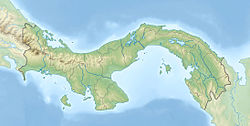Caraba Formation
Appearance
| Caraba Formation | |
|---|---|
| Stratigraphic range: Early Oligocene | |
| Type | Formation |
| Underlies | Las Cascadas & Caimito Formations |
| Overlies | Bas Obispo, Bohío & Panama Formations |
| Lithology | |
| Primary | Sandstone |
| Other | Conglomerate |
| Location | |
| Coordinates | 9°06′N 79°42′W / 9.1°N 79.7°W |
| Approximate paleocoordinates | 7°06′N 77°30′W / 7.1°N 77.5°W |
| Region | Panamá Province |
| Country | |
| Extent | Panama Basin |
| Type section | |
| Named by | Jones |
| Year defined | 1950 |
The Caraba Formation (Tcr)[1] is a geologic formation in Panama. The formation was first defined in 1950 by Jones as a facies member of the Caimito Formation.[2] The formation consists of poorly lithified, pebbly, tuffaceous, calcareous sandstones and conglomerates and preserves fossils dating back to the Early Oligocene period.[3]
Fossil content
[edit]The following fossils have been reported from the formation:
- Bivalves
- Gastropods
See also
[edit]References
[edit]- ^ Geologic Map, 1980
- ^ Woodring, 1957, p.29
- ^ Caraba Formation at Fossilworks.org
Bibliography
[edit]- Stewart, R.H.; Stewart, J.L.; Woodring, W.P. (1980), Geologic Map of the Panama Canal and Vicinity (PDF), USGS, p. 1, retrieved 2019-02-09
- Woodring, W.P (1957), Geology and Paleontology of Canal Zone and Adjoining Parts of Panama - 306A Geology and description of Tertiary mollusks (Gastropods: Trochidae to Turritellidae) (PDF), USGS, pp. 1–186, retrieved 2019-02-09

